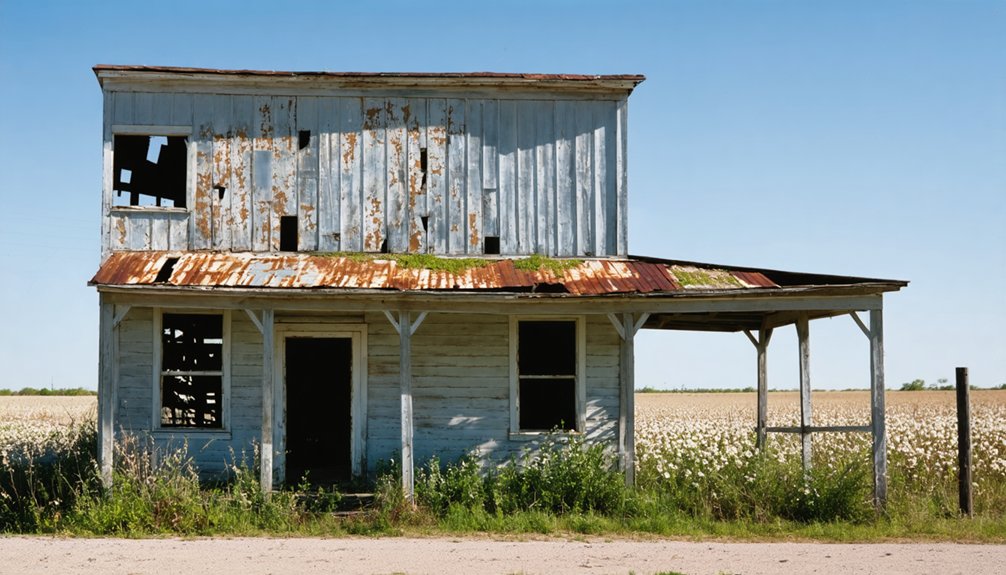You’ll find the limestone ruins of Stiles’ 1911 courthouse standing sentinel in West Texas, about 18 miles north of Big Lake on Highway 137. Founded in 1894 by William G. Stiles, this ghost town served as Reagan County’s first seat until 1925. When a landowner’s refusal to grant railroad right-of-way isolated the town in 1910, Stiles’ fate was sealed. The weathered courthouse walls hold tales of frontier dreams, ranching empires, and forgotten glory.
Key Takeaways
- Stiles was founded in 1894 and served as Reagan County’s first county seat until 1925 before becoming a ghost town.
- The town’s iconic limestone courthouse, built in 1911, still stands roofless and partially burned as the main remnant.
- Stiles declined after being bypassed by the railroad in 1910 and lost further prominence when oil was discovered near Big Lake.
- The ghost town can be accessed via Texas State Highway 137, approximately 18-20 miles north of Big Lake.
- Originally a ranching community, Stiles featured a post office, newspaper, schoolhouse, and courthouse before its abandonment.
The Birth of a Texas Frontier Town
In the spring of 1894, Stiles, Texas emerged from the rugged frontier landscape when William G. Stiles established the town’s first post office.
You’ll find this pioneer settlement nestled in what was then Tom Green County, where early settlers faced the daily challenges of carving out a life in cattle and sheep country.
As more ranchers and traders discovered the area’s rich pasturelands, the settlement’s growth accelerated.
By 1903, Stiles had grown significant enough to become the first county seat of the newly formed Reagan County. The measure passed with a decisive vote of forty to one.
The young settlement of Stiles reached a milestone in 1903, earning its place as Reagan County’s inaugural seat of government.
The Stiles Journal newspaper began publishing in 1907, marking a milestone in the town’s development.
The town’s future looked promising when Gordon Stiles and G.W. Shields donated land for development, leading to the construction of a majestic two-story stone courthouse in 1911.
Like many frontier towns, Stiles represented the bold spirit of Texas expansion.
Early Pioneers and Settlement
Gordon Stiles and Gerome W. Shields pioneered settlement in this high plains region of West Texas around 1880, establishing the first permanent foothold in what would become Stiles.
William G. Stiles, who secured the area’s first post office in April 1894, gave the settlement its lasting name and helped cement its position as an emerging frontier outpost. Like Stiles, Wisconsin, the town drew its name from early settlers who shaped its development.
P.H. Coates joined the early settlers in the 1880s, introducing sheep ranching to the area and setting the foundation for what would become a thriving livestock economy throughout the 1890s.
The emerging settlement achieved official recognition in 1903 when it became the county seat of Reagan County, though local folklore suggests the required population count included two mules named Bill and John Donuhu.
First Settlers Arrive
While Spanish explorers and Native Americans had long used the Centralia Draw area as a campsite, permanent settlement didn’t begin until Gordon Stiles and Gerome W. Shields arrived around 1890.
These Anglo-American settlers brought ranching innovations that would transform the rugged landscape. P.H. Coates, already familiar with the region from his 1880s visits, had established a progressive sheep operation featuring windmills and wire fencing before officially joining the settlement in 1894. Gordon Stiles’ store became the center of local activity. The area’s local ranches supported the initial growth and development of the community.
As the settlement grew, you’d have found a diverse mix of settler backgrounds, including Anglo-American ranchers and some Scandinavian immigrants who’d ventured into West Texas.
The growing community reached a milestone when Gordon Stiles successfully applied for a post office in 1894, cementing the settlement’s permanence in this strategic location along the historic Chihuahua Trail.
Stiles Family Legacy
The Stiles family name carried centuries of Anglo-Saxon heritage when it reached Texas, tracing back to pre-Norman England in 1066.
You’ll find their legacy deeply rooted in the geographic origins of “Stighele,” where they established themselves near rivers with abundant natural resources.
The Stiles heritage shaped Texas settlement patterns through:
- Gordon Stiles’s pioneering arrival in 1890, establishing vital ranching operations
- Strategic placement along the Butterfield Overland Mail route
- Influential land acquisitions that attracted other settlers to the region
Their Anglo-Saxon roots manifested in familiar settlement patterns, as they chose locations reminiscent of their ancestral preferences near waterways. Like early pioneers such as John Henderson who received a 320 acre land grant in 1840, the Stiles family understood the importance of securing substantial property. The family provided local guidance to surveyors that ultimately influenced Arkansas’s western border.
The family’s influence culminated in the establishment of Reagan County, where their namesake town of Stiles became the county seat in 1903 with overwhelming local support.
Ranching Community Forms
During the mid-1600s, Spanish captains Diego del Castillo and Hernán Martin first explored the land that would become Stiles, camping near Centralia Draw and discovering terrain well-suited for future settlement.
The region’s warm climate and semi-arid landscape proved ideal for sheep and goat ranching techniques, attracting pioneers like Gordon Stiles, Gerome W. Shields, and P.H. Coates in the 1880s.
As these early ranchers established their operations, community dynamics began taking shape around livestock raising.
You’ll find that their success drew more settlers to the area, transforming the isolated ranching outpost into a growing settlement.
The ranchers’ efforts laid the groundwork for official recognition, culminating in William G. Stiles securing approval for a post office in 1894, marking Stiles’s emergence as an established community.
Rise to County Seat Status
After years of steady growth in the late 1800s, Stiles emerged as the natural choice for Reagan County’s seat when the county formed on May 8, 1903, with an overwhelming vote of 40-1.
The town became a thriving center for sheep and goat ranchers in the region. You’ll find that the town’s rise to administrative power came naturally, as it was the only sizable settlement in the region at the time. In 1911, the town constructed a two-story courthouse to serve as the center of county government.
The path to county seat status was marked by several key developments:
- Gordon Stiles and G.W. Shields donated land for the county government
- A basic plank courthouse was built for $379, complete with a windmill
- Local civic engagement flourished as residents filled essential roles like judge, clerk, and sheriff
The Fateful Railroad Decision
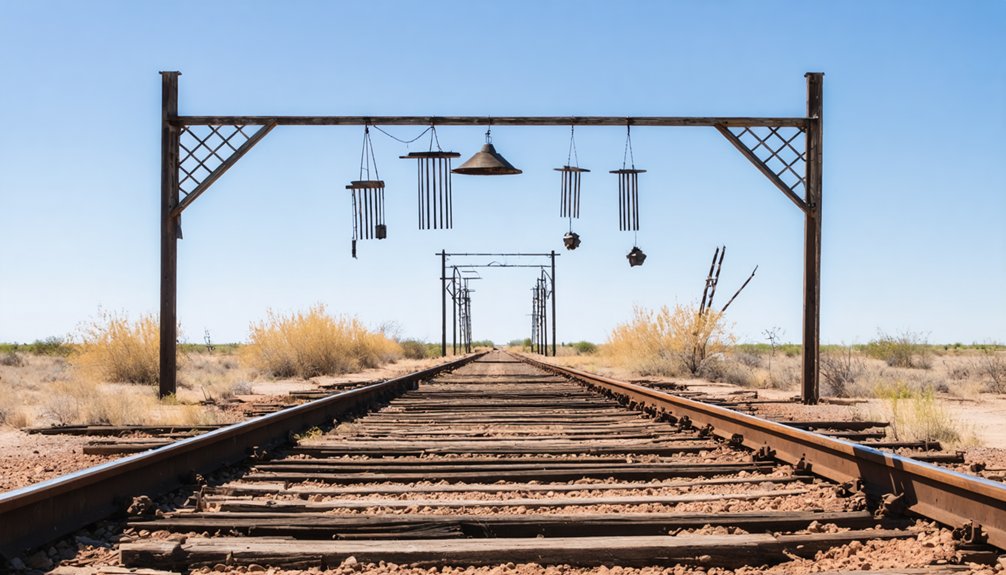
One pivotal decision in 1910 sealed Stiles’ fate when the Kansas City, Mexico and Orient Railroad bypassed the town entirely, opting instead for a route through what would become Big Lake.
You can trace this fateful turn of events to a stubborn landowner in Reagan County who refused to grant railroad access across their property. Instead, the railroad chose a southern route about twenty miles away, near a wildlife-rich lake that would inspire Big Lake’s name.
Without essential rail connections, you’d have witnessed Stiles’ gradual economic decline while Big Lake flourished.
By 1919, the new town had already matched Stiles in size, and when the Santa Rita oil well struck in 1923, Big Lake’s future was secured.
The railroad’s absence had effectively stripped Stiles of its chance to become a major commercial center.
Life in Early 20th Century Stiles
While ranching drove Stiles’ early growth, the town’s designation as Reagan County seat in 1903 transformed it into a bustling community hub.
You’d have found a tight-knit society of ranchers and their families, with community events centered around livestock sales, seasonal cattle drives, and courthouse activities.
Life in early Stiles revolved around these key elements:
- A new brick schoolhouse built in 1926 served local children
- The post office connected residents to the outside world
- County offices and basic businesses supported daily needs
Despite the town’s initial prosperity, economic challenges emerged when the railroad bypassed Stiles.
This decision left the community reliant on slower transportation methods like stagecoaches and wagons, while nearby rail-connected towns flourished.
The Iconic Stone Courthouse
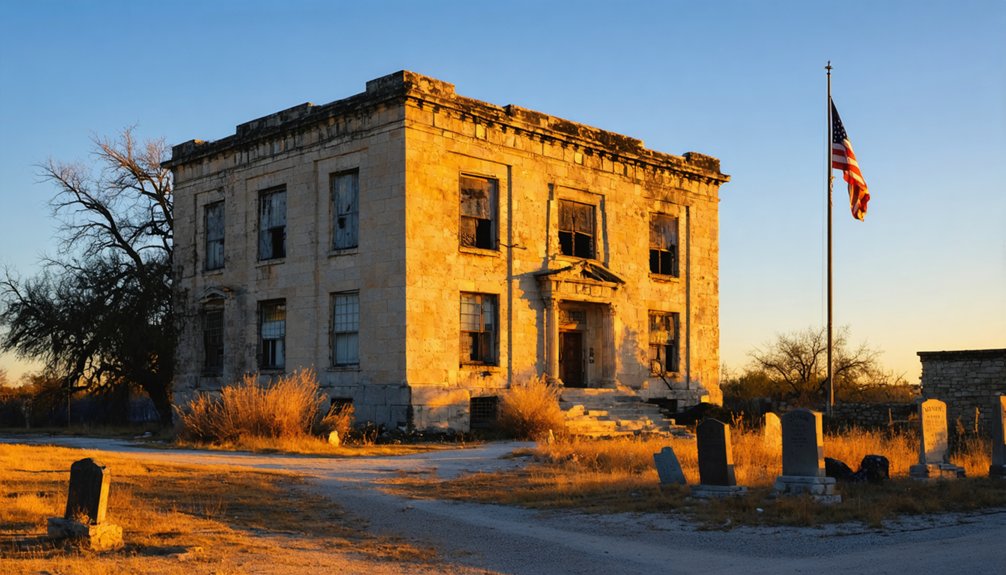
The majestic stone courthouse of Stiles stands as a symbol to Reagan County’s early aspirations. Built in 1911 from locally quarried limestone, its rusticated courthouse architecture featured a two-story design with an arched doorway typical of early Texas courthouses.
You’ll find this remarkable structure positioned near Centralia Draw, where it served as the county’s governmental center for 14 years.
Despite its brief official role, the building’s significance extends beyond its administrative function. When the railroad bypassed Stiles, the courthouse’s fate was sealed.
A devastating arson attempt in 1999 left the structure in ruins, and today’s historical preservation efforts are minimal. You can still view the fenced-off remains from an unpaved road off Highway 137, a reflection of the region’s pioneering spirit.
From Boom to Abandonment
You’ll find Stiles’ fate was sealed when a local landowner’s refusal to grant railroad right-of-way forced the Kansas City, Mexico and Orient Railroad to bypass the town in 1910-1911, routing instead through Big Lake 20 miles south.
The devastating impact of missing rail access caused businesses to relocate to Big Lake, draining Stiles of its economic lifeblood and eventually its county seat status in 1925.
The town’s iconic stone courthouse, once the symbol of Stiles’ prominence as Reagan County’s first seat of government, now stands roofless and abandoned – a stark reminder of how critical transportation infrastructure shaped the destinies of early Texas settlements.
Railroad’s Devastating Impact
Despite initial prosperity brought by rail connections in the late 1800s, railroads ultimately contributed to Stiles’ demise through shifting routes and consolidation practices.
You’ll find that railroad influence dramatically shaped the town’s destiny, as economic changes forced many small communities into decline when rail service diminished.
- The rise of competing transportation routes drew commerce away from established rail corridors.
- Railroad companies’ consolidation practices left smaller towns without reliable connections to markets.
- The shift of rail traffic to larger regional hubs isolated communities like Stiles from essential trade networks.
When railroads began prioritizing more profitable routes, you’d watch your town’s lifeblood slowly drain away.
This change mirrored the broader pattern of rural Texas communities that lost their economic foundation when rail service disappeared, leading to eventual abandonment.
Courthouse Legacy Ends
While railroad changes sealed Stiles’ economic fate, its courthouse legacy marked an even more dramatic chapter in the town’s decline.
You’ll find the 1911 limestone courthouse still standing as a silent sentinel to Stiles’ lost prominence, even though it served as the county seat for just 14 years.
After Big Lake won the contentious 1925 election to become Reagan County’s new center of government, the building’s identity shifted dramatically.
The courthouse didn’t completely lose its purpose, though. It briefly housed a school, hosted the Stiles Dance Club, stored road equipment, and even sheltered R.B. Fox’s family as a residence.
Today, this enduring structure’s courthouse preservation draws history enthusiasts seeking ghost town stories, though you can only view it from Highway 137’s roadside barriers.
Legacy of the Spanish Trail
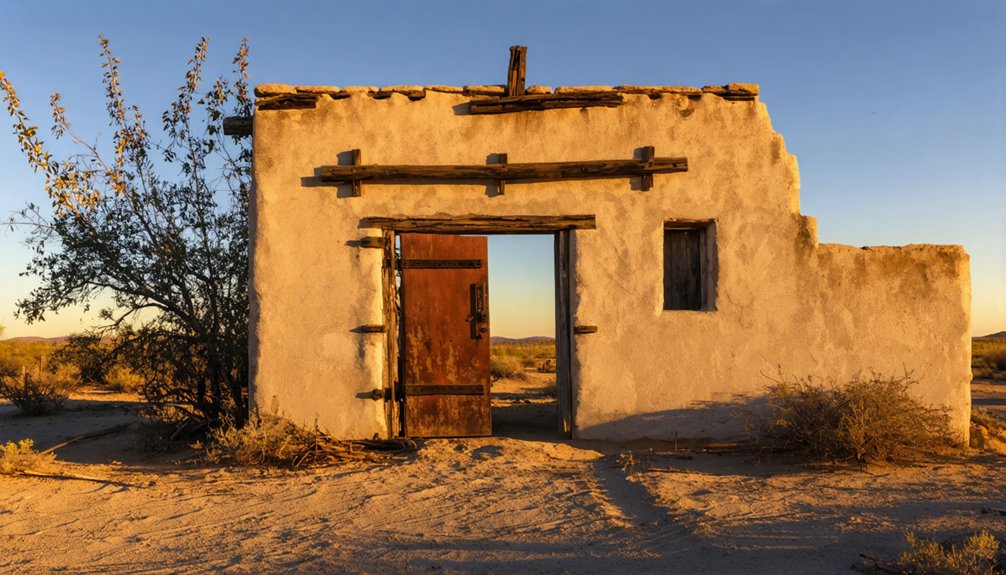
Long before modern highways crisscrossed Texas, the Old Spanish Trail served as a vital commercial artery linking Santa Fe to Los Angeles, with significant portions cutting through Texas territory.
Through this historic corridor, cultural exchanges and economic influences shaped communities like Stiles, connecting remote settlements to a broader network of trade and migration.
The historic pathway fostered vital connections between isolated frontier towns, weaving them into the fabric of a growing American nation.
In the 1910s, you’d find this legacy transformed into an auto highway spanning from St. Augustine to San Diego, with Texas playing a central role:
- Weekly meetings at San Antonio’s Gunter Hotel organized the highway’s development
- The route connected major Texas hubs including Beaumont, Houston, and El Paso
- Historical markers and remnants still dot towns like Sheffield and Bandera, preserving the trail’s memory
Modern Day Remnants
You’ll find the once-proud 1911 limestone courthouse of Stiles standing as a roofless shell behind protective fencing, about 20 miles north of Big Lake along TX-137.
The ruins serve as the most prominent reminder of this former Reagan County seat, where stone walls have endured despite two arson attempts in 1998.
While most structures have vanished, the old ranch roads that once connected this West Texas community remain visible through the desert brush, alongside scattered oil pump jacks that dot the landscape today.
Courthouse Ruins Today
Standing as a stark reminder of Reagan County’s past, the limestone ruins of the 1911 Stiles courthouse remain prominently visible from Texas State Highway 137, about 18-20 miles north of Big Lake.
The roofless structure, built by William Martin from locally quarried stone, stands protected yet deteriorating behind a tall security fence that restricts public access.
While you can’t enter the site, you’ll find these notable features:
- White limestone walls that have endured multiple arson attacks since 1998
- Rough, unpaved access road along Stiles Courthouse Loop
- Surrounding landscape dotted with oil pump jacks and desert brush
The courthouse’s current condition reflects minimal preservation efforts, with authorities focusing on preventing vandalism rather than restoration.
You’ll spot the ruins near the intersection of TX-137 and Highway 158, a monument to the region’s frontier heritage.
Ranch Roads Remain
Several ranch roads around Stiles remain as rugged monuments to the region’s ranching heritage, following paths established during the town’s heyday in the late 1800s.
You’ll find these unpaved routes still serving local ranching operations, though they’re primarily traversed by pickup trucks and ATVs suited for rough terrain.
While Reagan County provides occasional ranch road maintenance to keep these paths accessible, you’ll experience roads much as they existed in Stiles’ prime.
These historic thoroughfares hold significant cultural significance, marking the same routes that once connected sheep and cattle ranches before railroads arrived.
During wet seasons, you’ll want to exercise caution as these roads can become hazardous.
Today, they offer tangible links to the past, connecting abandoned homesteads and leading adventurous visitors to the famous courthouse ruins.
Historical Significance in West Texas
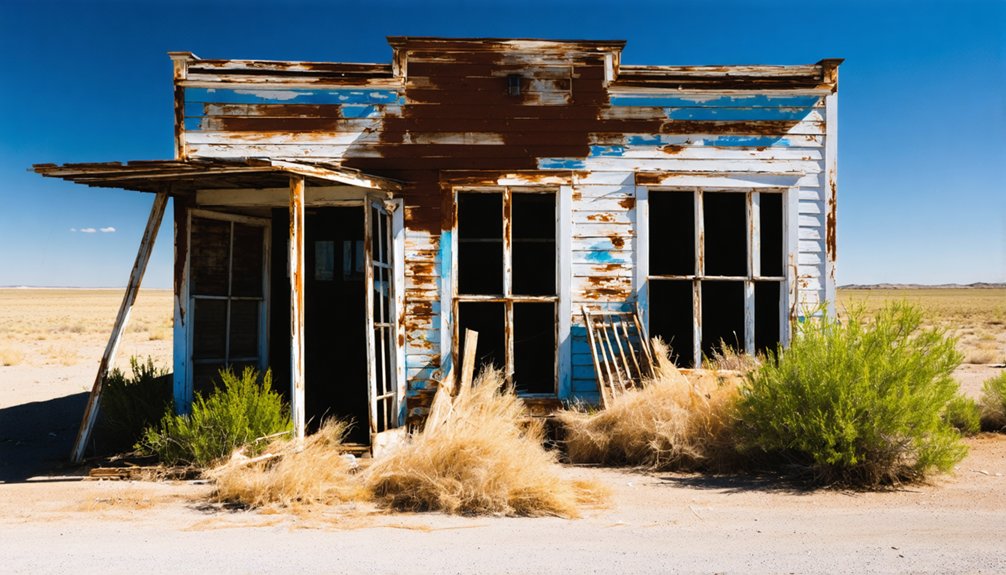
Stiles stands as a tribute to the dynamic forces that shaped West Texas settlements in the early 20th century. Its cultural heritage spans from Spanish exploration in the mid-1600s through its heyday as Reagan County’s first seat.
You’ll find the limestone courthouse ruins still watching over the landscape, a symbol of the town’s former prominence and economic decline.
- Founded in 1894, Stiles quickly became the area’s political center, winning the county seat designation by a decisive 40-1 vote.
- The town’s fate shifted dramatically when it missed securing railroad access, leading to Big Lake’s rise as the new commercial hub.
- The 1923 Santa Rita #1 oil discovery sealed Stiles’ destiny, as the region’s economic focus permanently moved away from ranching-based communities.
Frequently Asked Questions
Are There Any Dangerous Wildlife or Snakes Around the Stiles Ruins?
You’ll need wildlife safety awareness as Western diamondback rattlesnakes, prairie dogs, coyotes, and bobcats inhabit the area. Snake identification skills are essential when exploring these desert ruins.
Can Visitors Legally Explore and Photograph the Remaining Structures Today?
With 90% of ghost towns on private land, you’ll need landowner permission to legally explore or photograph Stiles’ ruins. There aren’t official visitor guidelines, but you must obtain photography permits through local ranchers.
What Items Have Been Found by Metal Detector Enthusiasts Near Stiles?
You’ll find a treasure hunter’s paradise of historical artifacts including Civil War-era buttons, rimfire bullet casings, Indian Head pennies, brass tokens, horse bits, and silver rings scattered throughout the soil.
Does Anyone Maintain or Protect the Remaining Structures From Further Deterioration?
Like a weathered sentinel standing guard, you’ll find Reagan County Historical Commission oversees structure preservation, but there’s limited historic maintenance funding, leaving most ruins to naturally decay without active protection.
Are There Any Documented Paranormal Activities at the Abandoned Courthouse Ruins?
You won’t find any confirmed ghost sightings or haunted history at the courthouse ruins – there aren’t any documented paranormal activities in official records, local histories, or credible visitor accounts.
References
- https://en.wikipedia.org/wiki/Stiles
- https://digging-history.com/2014/10/01/ghost-town-wednesday-stiles-texas/
- https://www.ghosttowns.com/states/tx/stiles.html
- https://www.austinchronicle.com/columns/2016-01-15/day-trips-stiles-texas/
- https://www.txgenwebcounties.net/reagan/markers/marker4.htm
- https://www.tshaonline.org/handbook/entries/stiles-tx
- https://www.texasescapes.com/TOWNS/Texas_ghost_towns/Stiles_Texas/Stiles_texas.htm
- https://picturesofthepast.com/abandoned/stiles-texas/
- https://digging-history.com/category/ghost-town-wednesday/page/5/
- http://genealogytrails.com/tex/hillcountry/reagan/courthouse_stiles.html
